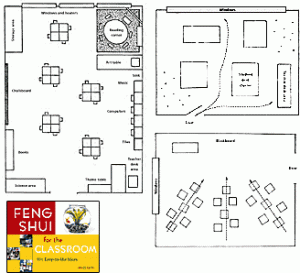How to Create a Focused Learning Environment
Try these tips for using feng shui concepts to fix classroom complications.
Your content has been saved!
Go to My Saved Content.This how-to article accompanies the feature "Give Your Space the Right Design."
Did you ever notice that the corners of Chinese pagodas are always turned upward? That is because in feng shui, pointed objects are as detrimental to health and wellness as actual weapons. The Chinese turn the corners of the pagodas upward so as to deflect the poison arrows from people who pass by.
Deflecting the Poison Arrows
Which of these negative influences do you have in your classroom?
- Long overhead beams.
- Desks in rows.
- Objects that point downward from the ceiling.
- Classroom door at the end of a long hallway.
- Sharp corners on tables and cabinets.
- Square pillows.
If you have any of these, you may use some of the following remedies:
- Add a mirror to reflect the sharp corners of pillars or cabinets back to the object, thereby containing the poison arrows within.
- Rearrange your desks so that they are not in a straight line.
- Hang garlands from the overhead beams.
- Wrap seasonal fabric strips around pillars.
- If your classroom is at the end of a long hallway, hang a mirror outside of your classroom to reflect the sheng chi.

Where Is Your Clutter?
There is both obvious and disguised clutter in a classroom. Obvious clutter is what you try to put away before Parents' Night. Disguised clutter is the file cabinet filled with old dittos, desk drawers that hold confiscated items from five years ago, and storage cabinets that have never been organized. Both forms of clutter affect the movement of chi.
Tackle the obvious clutter first. Ever wonder why corners become clutter traps? It's because we naturally try to soften edges and round corners, filling in the area made by a right angle. Chi also likes soft edges and round corners. Chi emanates from the center of a room in a circular pattern, much like the ripples in water when you drop a pebble into the lake.
What happens when this swirling chi finds a square corner? It becomes psychically sticky, trapped with no way out. As more chi becomes trapped in the corners, less is available to energize your classroom.
The Soft Touch
How can you soften those corners? You can try a number of suggestions:
- Hang a drape from one side of the corner to the other. (Remember to use the appropriate color and pattern for that corner as it applies to the controlling element.) Behind that drape, neatly stack your labeled boxes, preferably on shelves so the custodial staff can easily clean the floor.
- Use a Japanese-screen style of barrier. This is very effective in a reading corner, where you can use the screen to post pictures related to the text.
- Place wood or metal shelves (again, consider the controlling element for the corner) diagonally. If you are concerned about the visible cavity formed behind the shelves, string holiday lights behind them.
- Hang knotted rope or a bead curtain from the ceiling across the corner. Attach clothespins at regular intervals and hang student work. This is especially good in the recognition or possessions area of your room.
Excerpted from Feng Shui for the Classroom: 101 Easy-to-Use Ideas. © 2004 by E. Renée Heiss. Used with permission of Zephyr Press.